
The Battle of Stones River, also known as the Second Battle of Murfreesboro, was fought from December 31, 1862, to January 2, 1863, in Middle Tennessee, as the culmination of the Stones River Campaign in the Western Theater of the American Civil War. Of the major battles of the war, Stones River had the highest percentage of casualties on both sides. The battle ended in Union victory after the Confederate army's withdrawal on January 3, largely due to a series of tactical miscalculations by Confederate Gen. Braxton Bragg, but the victory was costly for the Union army. Nevertheless, it was an important victory for the Union because it provided a much-needed boost in morale after the Union's recent defeat at Fredericksburg and also reinforced President Abraham Lincoln's foundation for issuing the Emancipation Proclamation, which ultimately discouraged European powers from intervening on the Confederacy's behalf.

The Battle of Missionary Ridge, also known as the Battle of Chattanooga, was fought on November 25, 1863, as part of the Chattanooga campaign of the American Civil War. Following the Union victory in the Battle of Lookout Mountain on November 24, Union forces in the Military Division of the Mississippi under Maj. Gen. Ulysses S. Grant assaulted Missionary Ridge and defeated the Confederate Army of Tennessee, commanded by Gen. Braxton Bragg, forcing it to retreat to Georgia.
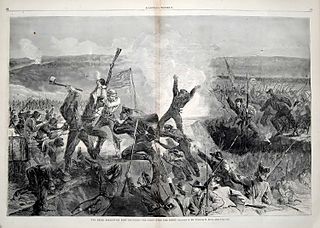
The Battle of Fort Sanders was the crucial engagement of the Knoxville Campaign of the American Civil War, fought in Knoxville, Tennessee, on November 29, 1863. Assaults by Confederate Lt. Gen. James Longstreet failed to break through the defensive lines of Union Maj. Gen. Ambrose Burnside, resulting in lopsided casualties, and the Siege of Knoxville entered its final days.

The Tullahoma campaign was a military operation conducted from June 24 to July 3, 1863, by the Union Army of the Cumberland under Maj. Gen. William Rosecrans, and is regarded as one of the most brilliant maneuvers of the American Civil War. Its effect was to drive the Confederates out of Middle Tennessee and to threaten the strategic city of Chattanooga.
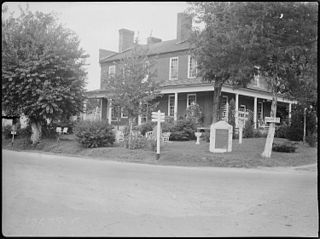
The Battle of Bean's Station was fought in Grainger County, Tennessee, during the Knoxville campaign of the American Civil War. The action saw Confederate forces commanded by Lieutenant General James Longstreet attack Union Army cavalry led by Brigadier General James M. Shackelford. After a clash that lasted until nightfall, Longstreet's troops compelled the Federals to retreat. Two cavalry columns that were intended to envelop Shackelford's force were unable to cut off the Union cavalry, though one of the columns captured 25 Federal wagons. On December 15, Shackelford was joined by some Union infantry southwest of Bean's Station where they skirmished with the Confederates before withdrawing again.

The Battle of Campbell's Station saw Confederate forces under Lieutenant General James Longstreet attack Union troops led by Major General Ambrose Burnside at Campbell's Station, Knox County, Tennessee, during the Knoxville Campaign of the American Civil War. Longstreet hoped to crush the Union Army of the Ohio forces before they could retreat to Knoxville. During the fighting, the Confederates forced the Union troops to fall back from five separate positions. However, the final result was that Burnside's troops conducted a successful fighting withdrawal.

The siege of Knoxville saw Lieutenant General James Longstreet's Confederate forces besiege the Union garrison of Knoxville, Tennessee, led by Major General Ambrose Burnside, in the American Civil War. When Major General William T. Sherman approached Knoxville with an overwhelming Union force, Longstreet ended the siege on December 4 and withdrew northeast. The siege was part of the Knoxville campaign of the Civil War.

The Knoxville campaign was a series of American Civil War battles and maneuvers in East Tennessee, United States, during the fall of 1863, designed to secure control of the city of Knoxville and with it the railroad that linked the Confederacy east and west, and position the First Corps under Lt. Gen. James Longstreet for return to the Army of Northern Virginia. Union Army forces under Maj. Gen. Ambrose Burnside occupied Knoxville, Tennessee, and Confederate States Army forces under Longstreet were detached from Gen. Braxton Bragg's Army of Tennessee at Chattanooga to prevent Burnside's reinforcement of the besieged Federal forces there. Ultimately, Longstreet's Siege of Knoxville ended when Union Maj. Gen. William Tecumseh Sherman led elements of the Army of the Tennessee and other troops to Burnside's relief after Union troops had broken the Confederate siege of Chattanooga. Although Longstreet was one of Gen. Robert E. Lee's best corps commanders in the East in the Army of Northern Virginia, he was unsuccessful in his attempt to penetrate the Knoxville defenses and take the city.

The First Corps, Army of Northern Virginia (or Longstreet's Corps) was a military unit fighting for the Confederate States of America in the American Civil War. It was formed in early 1861 and served until the spring of 1865, mostly in the Eastern Theater. The corps was commanded by James Longstreet for most of its existence.
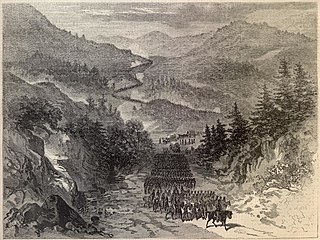
The September 7–9, 1863 fall of the Cumberland Gap was a victory for Union forces under the command of Ambrose Burnside during his campaign for Knoxville. The bloodless engagement cost the Confederates 2,300 men captured and control of the Cumberland Gap.

The Chattanooga campaign was a series of maneuvers and battles in October and November 1863, during the American Civil War. Following the defeat of Maj. Gen. William S. Rosecrans's Union Army of the Cumberland at the Battle of Chickamauga in September, the Confederate Army of Tennessee under Gen. Braxton Bragg besieged Rosecrans and his men by occupying key high terrain around Chattanooga, Tennessee. Maj. Gen. Ulysses S. Grant was given command of Union forces in the West which was now consolidated under the Division of the Mississippi. Significant reinforcements also began to arrive with him in Chattanooga from Mississippi and the Eastern Theater. On October 18, Grant removed Rosecrans from command of the Army of the Cumberland and replaced him with Major General George Henry Thomas.
The 10th Kentucky Infantry Regiment was a three-year volunteer infantry regiment that served in the U.S., or Union Army during the American Civil War.

The 125th Illinois Volunteer Infantry was an infantry regiment from Illinois that served in the Union Army during the American Civil War. Soon after mustering into Federal service in September 1862, the regiment fought at Perryville. After being stationed at Nashville, Tennessee, the unit briefly fought at Chickamauga and served in the Chattanooga and Knoxville campaigns in 1863. The regiment participated in the Atlanta campaign in 1864, where it took heavy losses at Kennesaw Mountain. It also fought at Peachtree Creek and Jonesborough. At the end of 1864, it served during Sherman's March to the Sea and in 1865 the unit fought in the Carolinas campaign. The regiment participated in the Grand Review of the Armies before being mustered out of service in June 1865.

The following Union Army units and commanders fought in the Knoxville Campaign and subsequent East Tennessee operations during the American Civil War from November 4 to December 23, 1863 under the command of Maj. Gen. Ambrose E. Burnside. Engagements fought during this time included the battles of Campbell's Station and Fort Sanders and the siege of Knoxville. Order of battle compiled from the army organization during the campaign and return of casualties. The Confederate order of battle is shown separately.
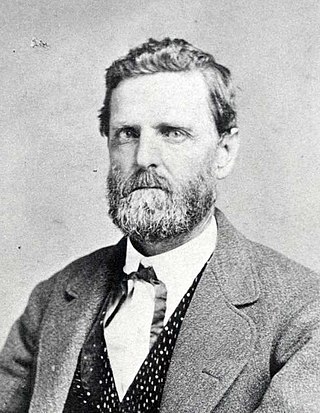
John Crawford Vaughn was a Confederate cavalry officer from East Tennessee. He served in the Mexican–American War, prospected in the California Gold Rush, and participated in American Civil War battles including First Manassas, Vicksburg, Piedmont and Saltville.

James Gallant Spears was an American general who served in the Union Army during the Civil War. Leading a unit composed primarily of Tennessee loyalists, he participated in early battles in the Cumberland Gap area before marching with the Army of the Cumberland at Stones River and Chickamauga. He later provided support for the Knoxville Campaign.
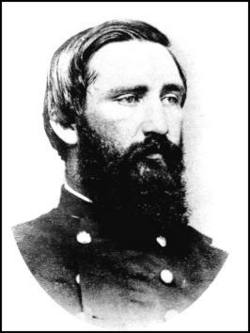
Sanders' Knoxville Raid saw 1,500 Union cavalry and mounted infantry led by Colonel William P. Sanders raid East Tennessee before the Knoxville campaign during the American Civil War. The successful raid began at Mount Vernon, Kentucky and moved south, passing near Kingston, Tennessee. Moving east from the Kingston area, the raiders struck the East Tennessee and Georgia Railroad at Lenoir Station. The Union horsemen rode northeast along the railroad, destroying track, bridges, and property useful to the Confederate States of America. Blocked from seizing Knoxville by its 1,000 Confederate defenders, Sanders' horsemen destroyed a major bridge across the Holston River at Strawberry Plains on the East Tennessee and Virginia Railroad. After wrecking a smaller bridge at Mossy Creek, the raiders turned northwest, evading pursuers by slipping through an obscure gap in the Cumberland Plateau. Sanders' men reached Boston, Kentucky on June 24, having captured and paroled over 400 Confederate soldiers while sustaining minimal losses in men but considerable losses in horses.

The Battle of Walker's Ford saw three Confederate cavalry brigades led by Brigadier General William T. Martin attack a Union cavalry brigade under Colonel Felix W. Graham at Walker's Ford on the Clinch River during the Knoxville campaign of the American Civil War. After failing to trap Graham's brigade at Maynardville, Tennessee, Martin's cavalry pursued in the direction of Tazewell before encountering Graham's horsemen south of Walker's Ford in the morning. At first, Martin's cavalry pressed Graham's troopers back. However, Brigadier General Orlando B. Willcox arrived with a Union infantry brigade and repulsed the Confederate cavalry. Martin sent a cavalry brigade to envelop the Union force, but it was blocked by one of Graham's regiments at a nearby ford. Martin's Confederates soon withdrew toward Knoxville. Willcox's tentative probe failed to relieve Major General Ambrose Burnside's defenders in the Siege of Knoxville, but Major General William T. Sherman's much larger forces soon accomplished that task.
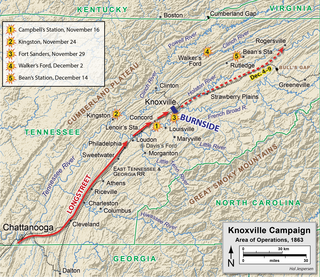
The Battle of Kingston saw Major General Joseph Wheeler with two divisions of Confederate cavalry attempt to overcome the Union garrison of Kingston, Tennessee, led by Colonel Robert K. Byrd. The Confederates mistakenly believed that the Kingston garrison was weak, but in fact, it comprised a brigade of infantry and a regiment of mounted infantry. When Wheeler's cavalrymen began probing the Union position, they discovered that its defenders were too numerous, and the position was too strong. The Confederate cavalry withdrew to rejoin Lieutenant General James Longstreet's forces in the Siege of Knoxville, but Wheeler himself returned to the Army of Tennessee near Chattanooga.
Henry Benedict Mattingly was a Union Army soldier in the American Civil War and a recipient of the United States military's highest decoration, the Medal of Honor, for his actions at the September 1, 1864, Battle of Jonesborough, Georgia.





















